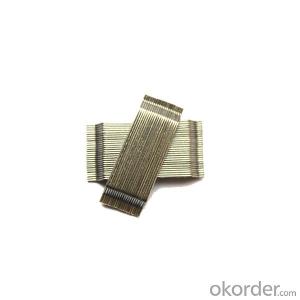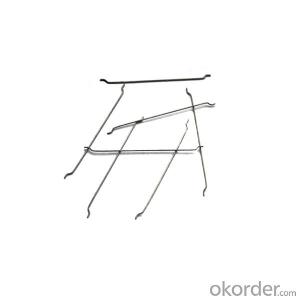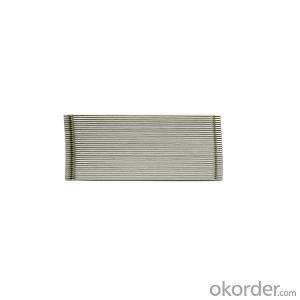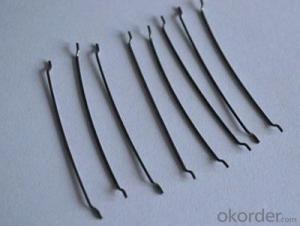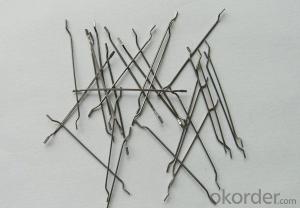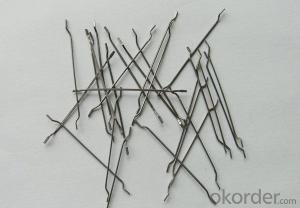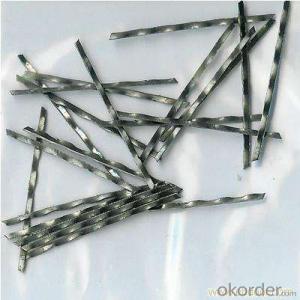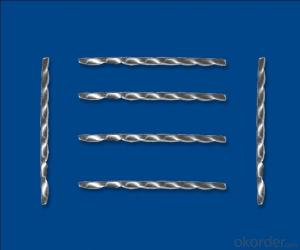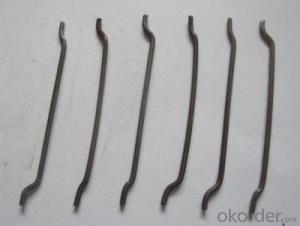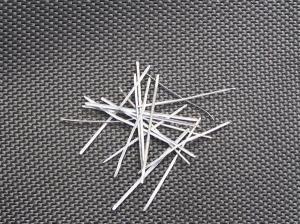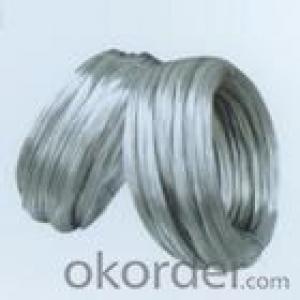>1200MPa ASTM A820M-11 Type 1 Steel Fibers
- Loading Port:
- Tianjin
- Payment Terms:
- TT OR LC
- Min Order Qty:
- 20 m.t.
- Supply Capability:
- 600 m.t./month
OKorder Service Pledge
Quality Product, Order Online Tracking, Timely Delivery
OKorder Financial Service
Credit Rating, Credit Services, Credit Purchasing
You Might Also Like
Quick Details
Place of Origin: Tianjin, China (Mainland)
- Model Number: 0.75
Material: Steel
Production Process: Cold drawn
Fiber Lengh: 60
Type: 1
Compressive Strength: >1200MPa
Aspect ratio: 80
Standard: ASTM A820M-11
Section Shape: Circular
Application: Concrete Reinforcement
- Product Uses: Industrial flooring
Packaging & Delivery
| Packaging Details: | 20 kg/Bag,50 bags/Pallet or 1,000kg/ Bulk Bag |
|---|---|
| Delivery Detail: | 1 Month |
Product Description
| Diameter | 0.75 | mm | 0.03 | in |
| Length | 60.00 | mm | 2.35 | in |
| Aspect Ratio | 80 | |||
| Tensile strength | 1200 MPa | |||
| Type | Cold drawn Steel Fiber | |||
| End | Hooked-end Steel Fiber | |||
| Glued/Loose | Glued Steel Fiber | |||
| Bending Angle | 45°(min.30°) | |||
| Usage & Performance | Floor:Trafficked areas and Industrial floors | |||
| Shotcrete :Slope stabilization and Final lining | ||||
| Precast concrete:Pipe and Railway sleepers | ||||
| Packing | Standard Export Pallet Packing | Bag Packing | 20 kg/Bag,50 bags/Pallet | |
| Bulk Packing | 1,000kg/ Bulk Bag | |||
| Loading Quantity | 20’GP | 20-25 Tonne/Tonnes | ||
| 40’GP | 25-27 Tonne/Tonnes | |||
| 40’HQ | 25-27 Tonne/Tonnes | |||
| MOQ | 1 kg for trial order | |||
| Supply Ability | 10,000 Tonne/Tonnes per Year | |||
| Payment Terms | T/T or L/C at sight | |||
| Delivery Time | Within 15 days after receiving deposit or original L/C at sight | |||
| Certification | ISO9001:2000, CE, | |||
| Product | Diameter | Length mm/in | Aspect Ratio | Type | Packing |
| G-6030 | 0.5 mm (0.0197 in) | 30 mm (1.1811 in) | 60 | Glued | 20 kg/Bag, or 1,000kg/ Bulk Bag |
| G-6535 | 0.55 mm (0.0217 in) | 35 mm (1.3780 in) | 65 | Glued | 20 kg/Bag, or 1,000kg/ Bulk Bag |
| G-6035 | 0.6 mm (0.0236 in) | 35 mm (1.3780 in) | 60 | Glued | 20 kg/Bag, or 1,000kg/ Bulk Bag |
| G-8060 | 0.75 mm (0.0295 in) | 60 mm (2.3622 in) | 80 | Glued | 20 kg/Bag, 50 bags/Pallet |
| G-6060 | 0.9 mm (0.0354 in) | 60 mm (2.3622 in) | 60 | Glued | 20 kg/Bag, 50 bags/Pallet |
| G-6030 | 0.5 mm (0.0197 in) | 30 mm (1.1811 in) | 60 | Loose | 20 kg/Bag, or 1,000kg/ Bulk Bag |
| G-6535 | 0.55 mm (0.0217 in) | 35 mm (1.3780 in) | 65 | Loose | 20 kg/Bag, or 1,000kg/ Bulk Bag |
| G-6035 | 0.6 mm (0.0236 in) | 35 mm (1.3780 in) | 60 | Loose | 20 kg/Bag, or 1,000kg/ Bulk Bag |
| G-8060 | 0.75 mm (0.0295 in) | 60 mm (2.3622 in) | 80 | Loose | 20 kg/Bag, 50 bags/Pallet |
| G-6060 | 0.9 mm (0.0354 in) | 60 mm (2.3622 in) | 60 | Loose | 20 kg/Bag, 50 bags/Pallet |
- Q:How does melt extract stainless steel fiber affect the shrinkage and cracking of concrete?
- The introduction of melt extract stainless steel fiber into concrete can have a significant effect on the shrinkage and cracking of the material. When incorporated into concrete mixtures, these fibers assist in controlling and reducing shrinkage during the drying and curing process. Shrinkage is a natural phenomenon in concrete as it loses moisture and undergoes hydration. This shrinkage can lead to the development of cracks on the concrete's surface, compromising its integrity and durability. However, the inclusion of stainless steel fibers can help address these concerns. The stainless steel fibers function as reinforcement within the concrete matrix, providing increased tensile strength and improved ductility. This reinforcement aids in distributing the stress and strain that occurs during shrinkage, thereby reducing the likelihood of crack formation. Moreover, the presence of stainless steel fibers in the concrete can enhance its resistance to plastic shrinkage cracking. Plastic shrinkage occurs when water evaporates from the concrete surface at a faster rate than it can be replenished, resulting in cracks. The fibers work to bridge any cracks that may form, preventing their propagation and ultimately diminishing the overall potential for cracking. Additionally, stainless steel fibers also enhance the concrete's overall durability by improving its resistance to impact, fatigue, and abrasion. This can lead to longer-lasting structures and reduced maintenance requirements for concrete constructions that incorporate these fibers. In conclusion, melt extract stainless steel fibers positively influence concrete shrinkage and cracking by providing reinforcement and enhancing overall durability. By controlling shrinkage and mitigating the risk of cracking, these fibers contribute to the long-term performance and structural integrity of concrete structures.
- Q:What is the effect of melt extract stainless steel fiber on the ductility of concrete?
- The addition of melt extract stainless steel fiber to concrete can have a positive effect on its ductility. Stainless steel fibers are known for their high tensile strength and excellent corrosion resistance, which can enhance the overall performance of concrete. When stainless steel fibers are added to concrete, they act as reinforcement, providing additional strength and stability to the material. This reinforcement helps to distribute stress and load more evenly throughout the concrete, thereby reducing the risk of cracking and increasing its ductility. Concrete with melt extract stainless steel fiber exhibits improved flexural strength, toughness, and resistance to impact and fatigue. The fibers act as a network within the concrete matrix, effectively bridging cracks and preventing their propagation. This bridging effect enhances the overall ductility of the concrete, allowing it to withstand greater deformation and maintain its structural integrity under various loading conditions. Furthermore, the corrosion resistance of stainless steel fibers ensures that they maintain their mechanical properties over time. This long-term durability contributes to the sustained ductility of the concrete, even in harsh environmental conditions or exposure to aggressive chemicals. Overall, the addition of melt extract stainless steel fiber to concrete can significantly enhance its ductility by providing reinforcement, improving crack resistance, and ensuring long-term durability. This improvement in ductility allows the concrete to better withstand external forces and maintain its structural integrity, making it a valuable addition to construction projects that require high-performance and durable concrete structures.
- Q:Can melt extract stainless steel fiber be used in high-performance concrete?
- Certainly, high-performance concrete can indeed utilize melt extract stainless steel fiber. Commonly employed as reinforcement, stainless steel fibers enhance the mechanical properties and durability of concrete. These specific fibers are produced by melting stainless steel and then drawing it into fine strands. Generally, a small quantity of these fibers is added to concrete mixes to enhance tensile strength, flexural strength, and resistance to cracking. The utilization of melt extract stainless steel fibers in high-performance concrete can significantly enhance its performance. Functioning as reinforcement, these fibers provide additional strength while impeding crack propagation. This is particularly vital for high-performance concrete, which aims to possess superior mechanical properties and resilience to harsh conditions. The incorporation of melt extract stainless steel fibers can optimize the concrete's ability to withstand impact, fatigue, and fire. It also aids in diminishing shrinkage and cracking, thereby extending the lifespan of concrete structures. Furthermore, stainless steel fibers possess corrosion resistance, which proves highly advantageous in environments where the concrete encounters aggressive chemicals or moisture. In summary, melt extract stainless steel fiber serves as a suitable and effective reinforcement material for high-performance concrete. It elevates the concrete's mechanical properties, durability, and resistance to cracking, subsequently enhancing the overall performance of the concrete structure.
- Q:Can melt extract stainless steel fiber be used in heavy-duty industrial pavements?
- Yes, melt extract stainless steel fiber can be used in heavy-duty industrial pavements. Stainless steel fibers are known for their high tensile strength, corrosion resistance, and durability, making them suitable for demanding applications such as heavy-duty industrial pavements. These fibers can enhance the concrete's mechanical properties, such as crack resistance, impact resistance, and abrasion resistance, thereby improving the overall performance and longevity of the pavement. Additionally, the use of stainless steel fibers can also reduce the need for traditional reinforcement methods, such as steel bars or mesh, leading to cost savings and easier construction. Overall, melt extract stainless steel fiber is a viable option for heavy-duty industrial pavements due to its exceptional properties and benefits.
- Q:What is the effect of melt extract stainless steel fiber on the modulus of elasticity of concrete?
- The inclusion of melt extract stainless steel fibers in concrete generally increases the modulus of elasticity. These fibers help in improving the tensile strength and stiffness of the concrete matrix, resulting in a higher modulus of elasticity.
- Q:Can melt extract stainless steel fiber be used in lightweight concrete wall panels?
- Yes, melt extract stainless steel fiber can be used in lightweight concrete wall panels. Stainless steel fibers are commonly added to concrete mixtures to improve the strength, durability, and crack resistance of the material. In lightweight concrete wall panels, stainless steel fibers can provide additional reinforcement without significantly increasing the weight of the panels. This allows for the creation of stronger and more stable lightweight concrete wall panels that can withstand various external forces and environmental conditions. Additionally, stainless steel fibers are corrosion-resistant, which further enhances the durability and lifespan of the wall panels. Therefore, melt extract stainless steel fiber is a suitable choice for reinforcing lightweight concrete wall panels.
- Q:How is melt extract stainless steel fiber manufactured?
- Melt extract stainless steel fibers are manufactured through a specialized process involving the melting of stainless steel alloys and subsequent extraction of the molten metal into tiny fibers. The manufacturing process typically starts with the selection of high-quality stainless steel alloys, which contain a combination of iron, chromium, nickel, and other elements. Firstly, the selected stainless steel alloys are heated to extremely high temperatures until they reach their melting point. This is typically done in a furnace or an electric arc melting system. Once the alloys are completely molten, they are ready for the extraction process. The molten stainless steel is then forced through a series of fine spinnerets or nozzles at high velocities. These spinnerets have small openings, which allow the molten metal to pass through and form continuous fibers. The size of the spinneret openings determines the diameter of the resulting stainless steel fibers. As the molten stainless steel exits the spinnerets, it rapidly cools down, solidifying into solid fibers. These fibers are then collected and further processed to remove any impurities or contaminants. This can be done through mechanical means such as air jets, or by chemical methods like acid washing or pickling. Once the fibers are cleaned and purified, they are typically cut into shorter lengths based on the desired application. The final product can vary in length depending on the specific requirements of the end user, ranging from a few millimeters to several centimeters. Overall, the process of manufacturing melt extract stainless steel fibers involves the melting of stainless steel alloys, extraction through spinnerets, cooling and solidification, purification, and cutting into desired lengths. This manufacturing process ensures the production of high-quality stainless steel fibers that can be used in various applications such as reinforcement in concrete, thermal insulation, and electromagnetic shielding.
- Q:Can melt extract stainless steel fiber be used in precast concrete products?
- Yes, melt extract stainless steel fiber can be used in precast concrete products. Melt extract stainless steel fiber is a type of reinforcement material that is added to concrete mixes to enhance their strength and durability. It helps to improve the tensile strength and crack resistance of the concrete, making it suitable for a wide range of applications, including precast concrete products. The stainless steel fibers are typically mixed into the concrete during the batching process and are evenly distributed throughout the mixture. This reinforcement can be particularly beneficial in precast concrete products that may be subjected to high loads or harsh environmental conditions. The addition of melt extract stainless steel fiber can help to prevent cracking and increase the overall lifespan of the precast concrete product.
- Q:Can melt extract stainless steel fiber be used in precast concrete cladding panels?
- Certainly, precast concrete cladding panels can make use of melt extract stainless steel fiber. To enhance the strength, durability, and crack resistance of concrete mixtures, it is common to incorporate stainless steel fibers. By integrating stainless steel fibers in precast concrete cladding panels, their structural integrity can be enhanced, along with an increase in resistance to impact and weathering. Moreover, the inclusion of stainless steel fibers can enhance the panel's ability to withstand corrosion, making it suitable for external applications. In summary, the addition of melt extract stainless steel fiber can greatly improve the performance and lifespan of precast concrete cladding panels.
- Q:What is the average length of melt extract stainless steel fiber?
- The specific application and manufacturing process often determine the average length of melt extract stainless steel fiber. Generally, this fiber ranges from a few millimeters to a few centimeters, which is ideal for improving the mechanical properties and durability of materials like concrete, composites, and refractories. It is important to mention that manufacturers can provide various lengths of melt extract stainless steel fiber to meet the specific requirements and preferences of their customers.
1. Manufacturer Overview |
|
|---|---|
| Location | |
| Year Established | |
| Annual Output Value | |
| Main Markets | |
| Company Certifications | |
2. Manufacturer Certificates |
|
|---|---|
| a) Certification Name | |
| Range | |
| Reference | |
| Validity Period | |
3. Manufacturer Capability |
|
|---|---|
| a)Trade Capacity | |
| Nearest Port | |
| Export Percentage | |
| No.of Employees in Trade Department | |
| Language Spoken: | |
| b)Factory Information | |
| Factory Size: | |
| No. of Production Lines | |
| Contract Manufacturing | |
| Product Price Range | |
Send your message to us
>1200MPa ASTM A820M-11 Type 1 Steel Fibers
- Loading Port:
- Tianjin
- Payment Terms:
- TT OR LC
- Min Order Qty:
- 20 m.t.
- Supply Capability:
- 600 m.t./month
OKorder Service Pledge
Quality Product, Order Online Tracking, Timely Delivery
OKorder Financial Service
Credit Rating, Credit Services, Credit Purchasing
Similar products
New products
Hot products
Hot Searches
Related keywords

